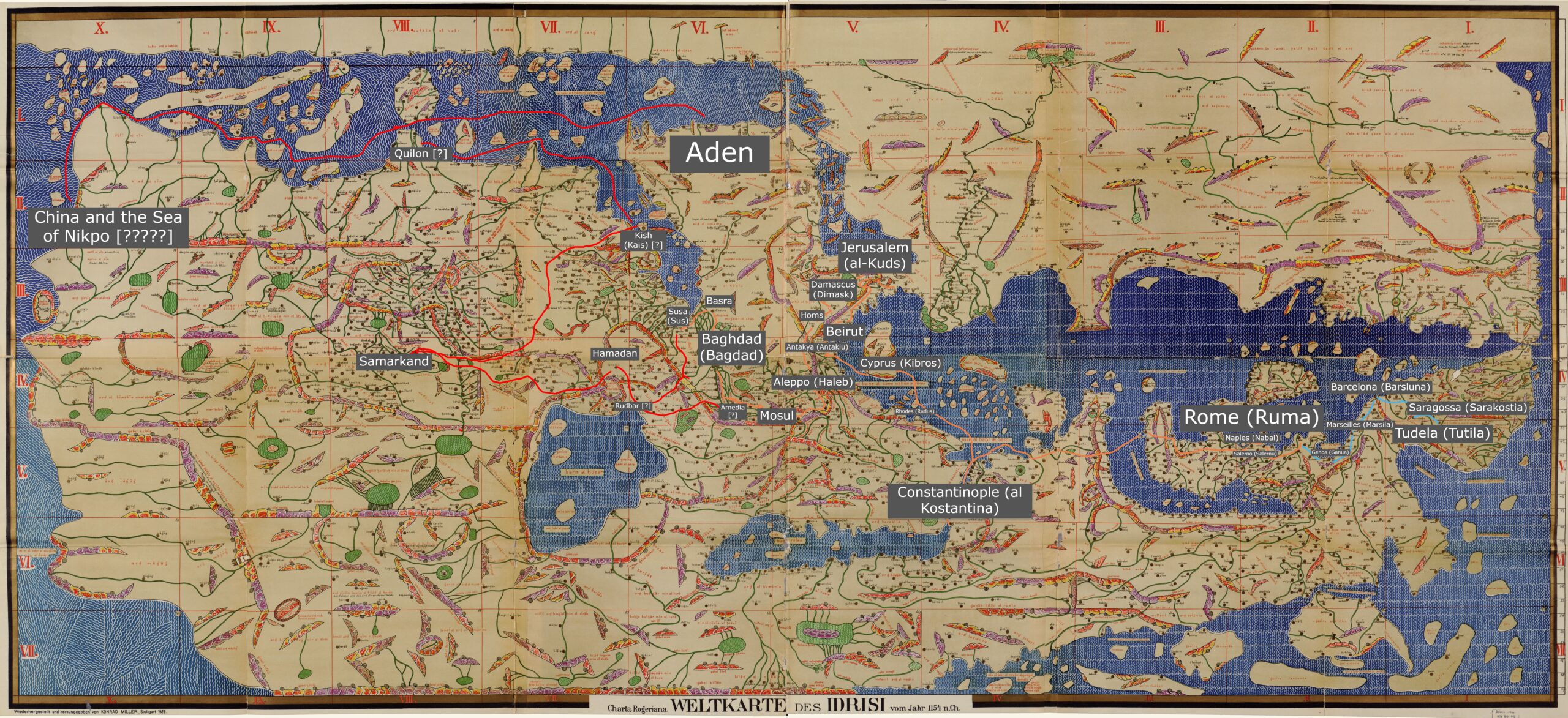Unsurprisingly, plotting the journey of Benjamin of Tudela on both a modern and medieval map shines a light on many differences in the way that we view the world as opposed to Benjamin of Tudela.
The first glaring fact when it comes to the visualization on the medieval map is the scope. When looking on a modern map, his travels are impressive, even if one removes the places that he likely did not get to. The Tabula Rogeriana, on the other hand, makes his reported journey stretch from one end of the world to the other (not literally, for it was common knowledge for hundreds and hundreds of years that the world was round). From “Tutila” to “al-Sin”, the particular distortions of this map make it seem that Benjamin of Tudela had passed through a majority of the world’s lands. This is in addition to the fact that the points that are plotted in this map are not representative of his entire itinerary, so there are even more lands that he wrote he had passed through.
There are three major distortions that seem to cause the scope of Benjamin of Tudela’s journey to grow. The first is that Europe is enlarged, and Asia and Africa are diminished, making the lands that he wrote about in more detail (because he actually went to these places) appear more significant than the lands that he spent less time in. The second is the absence of the Americas for obvious reasons. The third is the many distortions made to the southern hemisphere. There is land in these areas, but the shape of almost anything south of Arabia is entirely unrecognizable and seemingly much less dense in terms of geographical features and settlements. This creates the impression that that there isn’t much of import to explore in that part of the world, and the viewer values more the lands that Benjamin’s journeys were meant to have taken place.
While the broad scope of his journey appears more impressive, some of the distances between particular locations seem more reasonable on the medieval map than on the modern. The locations marked in red on the modern map indicate places that Benjamin of Tudela likely did not travel to, and the decision of whether or not it was likely he went to a particular location was made mostly based off the fact that the routes that he would have had to take were highly erratic and nonsensical.
There are two main reasons why this is not quite the case on the medieval map. First off, some of the locations that he wrote about were not featured on the Tabula Rogeriana, particularly Rudbar and Amedia. These locations’ absence make it plausible that contemporaries could have believed that Rudbar and Amedia were on the route from Susa to Hamadan, making Benjamin of Tudela believe he could pass off actually going through those locations. This theory would further exemplify that Benjamin of Tudela did not really travel to these places, and that common knowledge was that Rudbar and Amedia were inland towns betwen Susa and Hamadan.
The second reason is that land distortions make routes that are actually irrational appear more reasonable. A significant example of this is the distance between Hamadan and Samarkand. On the Tabula Rogeriana, it visually appears to be about the same distance as that between Hamadan and Aleppo (Haleb). In reality, the direct distance between Hamadan and Aleppo is roughly 650 km, while the distance from Hamadan to Samarkand is over 1000 km. At this point, Benjamin of Tudela had traveled well over 1000 km, but in his itinerary there is shockingly little information about the lands between these two places. In the text, it appears as if the journey between Hamadan and Samarkand is no big deal, while in reality it makes absolutely no sense how he could have gotten that far east given the textual evidence to work off of.
